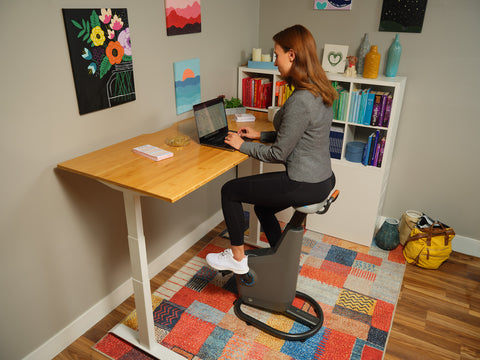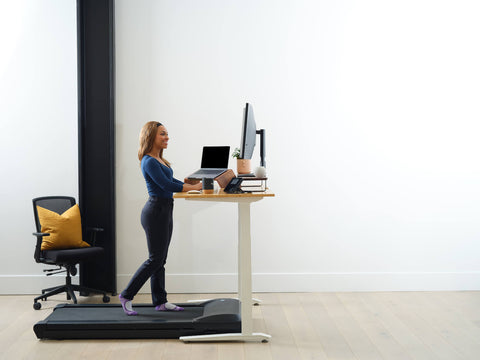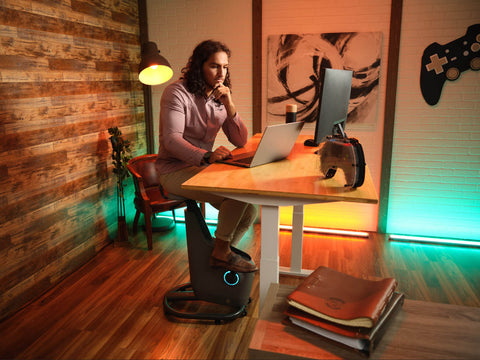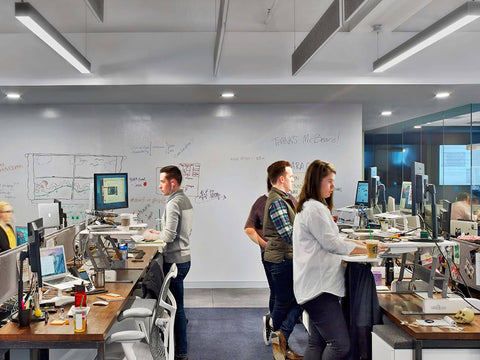Standing more while you work is the first smart choice you can take toward managing your health and combating the long-term effects of sitting all day; and although standing desks and accessories may seem like just another trend sweeping workplaces, there’s a whole lot of science to back up just why they’ve become so popular.
Read on as we cover everything you (an employer concerned about workplace wellness, an employee concerned about your own health, or anyone who works at home that is simply seeking better options) need to know about standing in the workplace.

Standing for the health of it
You don’t have to look far and wide to find research that shows how standing while you work can benefit you, but here’s the gist of what you will find.
Standing benefits:
- ✔ Reduce risk of obesity
- ✔ Reduce risk of type 2 diabetes
- ✔ Reduce risk of cardiovascular disease
- ✔ Reduce risk of cancer
- ✔ Reduce back and neck pain
- ✔ Lower long-term mortality risk
- ✔ Boost productivity

Rising costs to employers
Companies lose a lot of money when employees are sick — like $225.8 billion annually a lot. That’s more than the cost of cancer, by the way. This estimate comes from the Centers of Disease Control and Prevention (CDC), which further breaks it down to a productivity loss of $1,685 per employee when they miss work.
Employees want to stand
![]()
A poll conducted by Government Product News (GPN) found that 53% of government workers want standing desks, but only 23% are currently using one; many companies, however, are working rapidly to meet the demand. Standing desks have become the fastest-growing employee benefit according to a mid-2017 report from the Society for Human Resource Management (SHRM), whose annual survey of HR professionals saw 44% of respondents answer that their company provided or subsidized standing desks for employees. That number was just 13% in 2013.
Standing is great, but it’s not enough
All of the above may have convinced you to get a standing desk pronto, which is awesome, but it’s really just the first step you should take on your journey to workplace wellness. One recent study published in December 2017 found that when participants used a device that allowed them to swing or move their feet at random while sitting, their metabolism was elevated by about 17% compared to when they were just sitting or standing with no movement. Translation: more calories were burned when movement was added.
The research is clear; your goal should not be to simply stand, but also to move — more. That’s where standing accessories come in.

A basic no-frills standing mat can work wonders to reduce stress on legs and feet when standing for an extended period, but a contoured mat or a balance board can do even more. Both encourage movement and allow you to stretch lower limbs while standing, which is essential for combating back pain and postural fatigue. Most of the anti-fatigue mats you will find on the market fall into one of three categories: a flat standing mat, a contoured or sloped mat, or a standing board that encourages movement and balance.
Standing mat

This anti-fatigue mat is the most common variety found in office environments, but it is also the most limited in terms of provided benefits. Generally it has a set thickness across the whole mat that ranges from ½” to 1” and different mats come with varying levels of resistance to indentation. These mats provide even support for the entire foot, as well as activation of the surrounding muscles, which makes standing on them for longer periods of time more comfortable than standing on a hard or carpeted floor surface alone. We recommend choosing one with a beveled edge that helps to avoid tripping over it.
Contour standing mat

These mats, also referred to as terrain or formed mats, are designed to allow for multiple foot positions when standing, which in turn supports joint movement in your ankles, knees, and hips. They are usually made from the same flexible material as most flat standing mats, but one key difference is that these uniquely shaped mats allow you to more easily change up your feet placement so you can effortlessly stretch your lower body. One important consideration with this type of mat is to look for one that will best support natural foot movement. Although there are some mats available that appear to have cool and interesting surfaces, they might cause you to trip or lose your balance. We recommend selecting one with a wide standing area and gradual sloping of the edges that is also on the firm side so it will retain its shape.
Standing or balance board

Balance and movement boards are the most recent members to join the active standing family. Their unique designs allow you to further engage your muscles and joints by rocking back and forth or side to side. Most require some level of engagement in the core muscle group to maintain stability. Intrepid types might opt for a balance-training version that offers a challenge to stay upright and mimics surfing, while others might prefer a more stable surface with cushion underneath that still allows for gentle movement, but reduces the chance of personal injury. For the workplace, we recommend choosing a board without extreme balance requirements, or our AirSoft cushion standing board, which is adjustable to provide both experiences.
Getting started and ramping up
What’s the right balance between sitting, standing and moving? If you read this article and try to stand all day when you have been mostly sitting, you’re going to be miserable. Your feet will ache and your legs and back might hurt as your muscles strain to keep up with a demand they aren’t used to. We recommend that 25-50% of your work day include varied movement such as standing with a mat or a balance board, walking on a treadmill desk, or using a bike desk.

Expert Tip
Allan Hedge, director of Cornell University's Human Factors and Ergonomics programs, suggests varying a 30-minute period by sitting 20 minutes, standing 8 minutes, and moving around and stretching for two minutes. He also recommends that when you are sitting, make sure to use good posture. Check out his 10-step ergonomic guidelines for workstations.
Office culture and why it matters
It’s important for employers to create a work culture that embraces wellness. You can’t just buy standing desks for your employees and hope to see healthcare costs magically drop and productivity skyrocket. Well … you could, but you’ll see a lot more success if you work with employees to help them realize health goals. A good place to start would be to create a wellness program with rewards for active participants who regularly meet challenges and goals. Another great option is to appoint wellness advocates throughout your organization who will champion your health vision among other employees. Chances are you already have a handful of employees who are passionate about healthy living who would welcome the opportunity to revolutionize their workplace so that it harmonizes with their active lifestyle outside of the office.
So that’s it! We hope you enjoyed this compelling roundup of reasons why standing and moving more at work is the way to go and how you can stand up for your health (cliché — we know).
More great resources
Check out our buyer's guide on selecting the best standing desk for you and your workplace
Learn the health risks of a sedentary lifestyle
Increasing your productivity and health in the workplace









